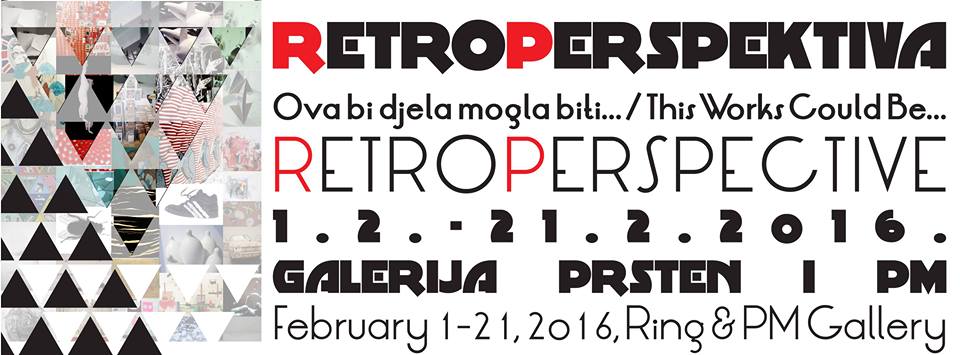EXHIBITION: RETROPERSPECTIVE – These Works Could Be…
RETROPERSPECTIVE – These Works Could Be…
February 1 – 21, 2016
PM Gallery and Ring Gallery
EXHIBITORS: Grgur Akrap, Željko Badurina, Gordana Bakić, Snježana Ban, Gordana Bralić, Tomislav Buntak, Božena Končić Badurina, Iva Matija Bitanga, Jelena Bračun Filipović, Igor Čabraja, Iva Ćurić, Viktor Daldon, Ivan Fijolić, Ivana Franke, Ivana Gorički, Željka Gradski, Marko Grill, Tea Hatadi, Ana Hušman, Zdravka Ivandija Kirigin, Đorđe Jandrić, Igor Juran, Marija Knezić, Jasminka Končić, Ana Krolo, Ines Krasić, Daniel Kovač, Nina Kurtela, Tomislav Lončarić, Marija Lovrić, Hrvoje Majer, Ivica Malčić, Janko Matić, Miroslav Mirt, Maja Marković, Božica Dea Matasić, Margareta Milačić, Zoltan Novak, Petra Orbanić i Marija Plečko, Dan Philipp, Predrag Pavić, Terezija Pisković Barusić, Vesna Pokas, Iris Poljan, Lala Raščić, Bruno Razum, Davor Rogar, Berislav Šimičić, Natalija Škalić, Tanja Škrgatić, Josipa Štefanec, Anita Šurkić, Karla Šuler, Ivan Tudek, Zorana Unković, Iva Vraneković, Miriam Younis, Ana Zubak
In the vast multitude of contemporary art production nothing stands out for too long; it is like a work lives only for a moment, only to fall into oblivion a moment later. When things are so fast paced, some things manage to become a phenomenon, and some others, although valuable, inexplicably go unnoticed and remain incidental, forgotten in the end. These are, of course, some commonly adopted conclusions and mechanisms characteristic of the (contemporary) art system, which can remind us that it is sometimes necessary to resist the tendency and habit of fast consumption and oblivion, invite us to give a second look at those artistic values that deserve to be remembered, but slip by too quickly in this time of general relativism, dispersion and indifference.
In the present context it is important to look at individual and group artistic achievements of the generation of artists of the last decade and more, and exhibit together both the works that have become paradigmatic on the young art scene and the ones that passed unnoticed, but which “could be of historical importance.“[1]
We are, in fact, interested in what happens with the works after a length of time. Can “the historically suppressed contents be revised, revalued, though-out and become functional in the future, through the negation of the concept of linear development in time.“[2] In other words, will the exhibition of “forgotten“ works have a more important significance today than in the time when they were created? To what extent is it possible to expect a kind of catharsis, so to speak, or a revaluation, reaffirmation of the established values?
After all, what is of crucial importance for the recognition of an art phenomenon? Is it based on the current trends or an author’s identity, or on a somewhat bitter realization that “the fact that someone was given the opportunity to make an exhibition is more important than what will actually be shown at that exhibition.“[3] These are some of the considerations and fundamental issues that the exhibition wants to clarify and demonstrate, in order to provide at least partial answers, and possibly raise some new questions.
We believe that exhibited together, the selected works may come somewhat as a surprise. The exhibition includes works by several generations of artists who, among other things, share the same educational roots, i.e. they graduated from the Department of Art Education (Academy of Fine Arts in Zagreb). The works in question were created during their studies, in their formative period, the most sensitive period of searching for their own artistic identities. The period covered is not defined by a strictly limited time frame, but by preserved works, their availability, existing documentation, reconstruction, author’s willingness. Also, the specific importance, or characteristic of the proposed concept, is the inner perspective of the protagonists themselves – artists in the role of the curator, who have this experience.
Snježana Ban, Tea Hatadi, Ante Rašić
The exhibition is financially supported by the City Office for culture, Education and Sports Zagreb and by The Ministry of Culture of the Republic Croatia.
WORKING HOURS
Tuesday to Friday 11am – 7pm
Saturday and Sunday 10am – 6pm
Mondays and holidays – closed
Dom hrvatskih likovnih umjetnika
Trg žrtava fašizma 16
10000 Zagreb
[1] Paraphrasing the famous title of Braco Dimitrijević’s photographic works.
[2] Branko Franceschi, from the foreword to Željko Kipke’s exhibition, explaining retrofuturism in his work.
[3] From Goran Trbuljak’s famous work.
SUMMER WORKING HOURS PRSTEN GALLERY, BAČVA GALLERY AND PM GALLERY (Home of HDLU)
Tuesday – Sunday: 9am – 12pm / 4pm – 8pm
Mondays and holidays closed.
WORKING HOURS GALLERY KARAS
Wednesday - Friday: 3pm - 8pm h Saturday and Sunday: 10am - 1pm h Mondays, Tuesdays and holidays closedHome of HDLU
Trg žrtava fašizma 16, Zagreb, Map...
T + 385 (0) 1 46 11 818, 46 11 819 F + 385 (0) 1 45 76 831 E-mail: info@hdlu.hr
For all Exibitions in our Galleries right now, please visit EXIBITIONS SECTION ...
Rss feed
Trg žrtava fašizma 16, 10000 Zagreb, Croatia
tel: 385 1 /4611 818 / 4611 819
fax: 4576 831, E-mail: hdlu@hdlu.hr
Trg žrtava fašizma 16, 10000 Zagreb
Tel: 385 1 46 11 818, 385 99 732 6127
E-mail: pm.hdlu@gmail.com
Gallery Barrel, Trg žrtava fašizma 16, Zagreb
tel: 385 1 4811 561, 385 98 982 8989
E-mail: hdlu.hr@gmail.com




